I’ve lived an intermittent fasting lifestyle for over a year! One of the reasons I choose this approach is becasue I can enjoy carbs and other foods that I like.
Today I will explain if you can have carbs on one meal a day intermittent fasting, and if so, which ones should you eat.
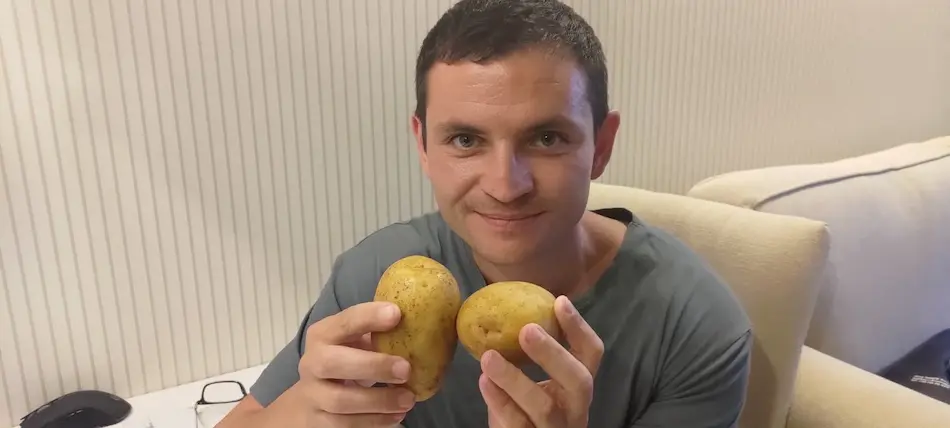
Does OMAD allow you to eat carbs?
Unlike other diets that restrict carbohydrates (e.g., ketogenic diet, low-carb, or carnivore), one meal a day allows me to eat all types of food.
I started doing one meal a day after many years of trying and testing different diets. All these different diets made me believe that carbs are bad.
And, if I want to lose weight, I should avoid them. Doing OMAD for over a year helped me to regain my healthy relationships with carbs.
Plus, I also noticed that regardless if I eat carbs (or not), I still maintain my weight loss results.
How many carbs to eat on OMAD?
I started doing the OMAD diet by eating approximately 50-100g of carbs per day. This is equivalent to 2-3 medium size potatoes, 2 pieces of burrito, or 1 cup of rice with baked beans.
Here is the photo of my plate filled with potatoes and chicken from the day before.
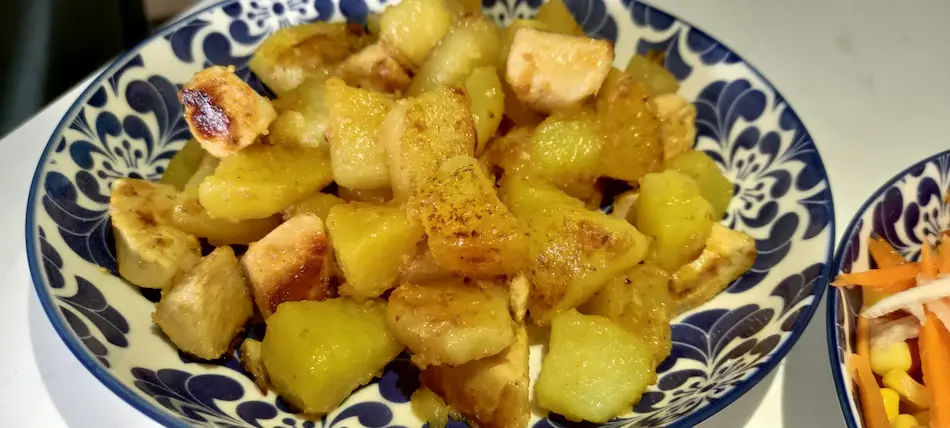
(On the side plate, I also have a salad made of sliced carrots, sweetcorn, and some veggies.)
Although I don’t usually count calories or macros, I prefer to eat more carbs during my wokrout days (around 3-4 days per week). That’s when you can see me eating chocolate, ice creams, and macaroni with cheese.
It’s very rare for me to go over 100 grams of carbs (even on training days), unless we travel or spend the night out with our buddies.
Benefits I’ve experienced with eating carbs with OMAD
- Eating what I love
- Relax from stress
- Getting better sleep
- More energy
- Fewer food cravings
- Higher satiety
Eating what I love
I remember being stuck on a diet where I couldn’t eat the foods that I want. This was a problem, especially during my social time. I wasn’t able to go out with friends and have a normal meal.
With OMAD, I can finally enjoy the foods that I love like pasta, bread, ice cream, and even pizza without guilt.
Here is the photo of my favorite ice cream, Haagen Dazs that I often have after my OMAD meal.

Plus, I no longer have to look up the restaurant’s menus in advance and decide what I eat.
Relax from stress
I often find that eating carbohydrates calms me down, especially a stressful work week.
Of course, eating food to release my stress is not an ideal solution, but according to the article published by Psychology Today, people who consumed a carbohydrate-rich beverage experience less anger, depression, anxiety, and irritation.
According to the article, eating carbohydrates helps to make serotonin, which makes us feel calmer and more relaxed.
Getting better sleep
Being more relaxed means deeper and more rested sleep. I feel like I don’t have problems falling asleep anymore, and I can easily wake up before sunset without having to hit the snooze several times.
I prefer to eat my one meal a day in the evening, around 3-4 hours before going to bed. Having 50 to 100 grams of carbs (including a glass of wine) doesn’t deplete my iron willpower. Instead, I helps me to recover for the next day.
I have more energy
Although I usually have a decent amount of energy during the day, eating carbs with OMAD certainly makes it better.
I can do my resistance training without having to worry about my performance. I can do 20-30 minutes of morning cardio, and I know I won’t feel tired later that day.
Here is the photo of me playing around in my gym kicking a boxing bag.

Also, my wife doesn’t complain anymore as having carbs more in my OMAD diet seems to help in the bedroom department.
Fewer food cravings
Eating carbs not only helps me to maintain my energy levels but also stops my cravings for sweets during the day.
According to a clinical trial published in the International Journal of Eating Disorders, if you feel like you have a hard time saying no to food, and you constantly have food cravings, it is much better to let it go and eat what you crave.
“Long-term deprivation from foods that you like (and want) can trigger unwanted, overeating behaviors,” according to the article.
Higher satiety
My favorite source of carbs is potatoes becasue of the taste and satiety. According to the satiety index published in the European Journal of Clinical Nutrition, potatoes have the highest score.
Regardless if I eat them boiled, fried, or baked, they always keep me fuller for longer. I tried eating one meal a day without carbs, but I wasn’t feeling satisfied or full.
Benefits of eating carbs according to research
Eating carbohydrates in moderation has been associated with a lower risk of mortality. In the observational study of more than 15,400 people, the researchers estimated the average life expectancy was 4 years longer than those with very low carbohydrate consumption.
In the article recently published in Atherosclerosis Journal, the research suggests that low-carb diets may cause rapid and sensible weight loss, but also a substantial rise in low-density lipoprotein cholesterol levels. This makes the physicians uncertain to endorse it.
Carbohydrates help to replenish glycogen levels, especially after endurance training. On the contrary, a low carbohydrate diet results in greatly reduced liver and muscle glycogen stores, which can limit endurance exercise performance.
What type of carbs I eat on OMAD?
When it comes to carbs, I like to mix things up and enjoy a variety of different types. In my OMAD diet, I’m eating rice, pasta, bread, or potatoes.
Although most of my meals include proteins (chicken, beef, etc.) I always make sure to get a variety of carbs.
Keep in mind that carbs contain a variety of essential nutrients, including fiber, and a variety of vitamins and minerals, which is important for me if I only eat once a day.
Potatoes
Apart from the aforementioned satiety benefits, I often choose potatoes becasue they are a good source of fiber, which helps to keep me regular. They’re also packed with vitamins and minerals like potassium, iron, and vitamin C.
Here’s photo of my typical OMAD meal that inlcude potatoes and chicken on one plate and salad on the other.
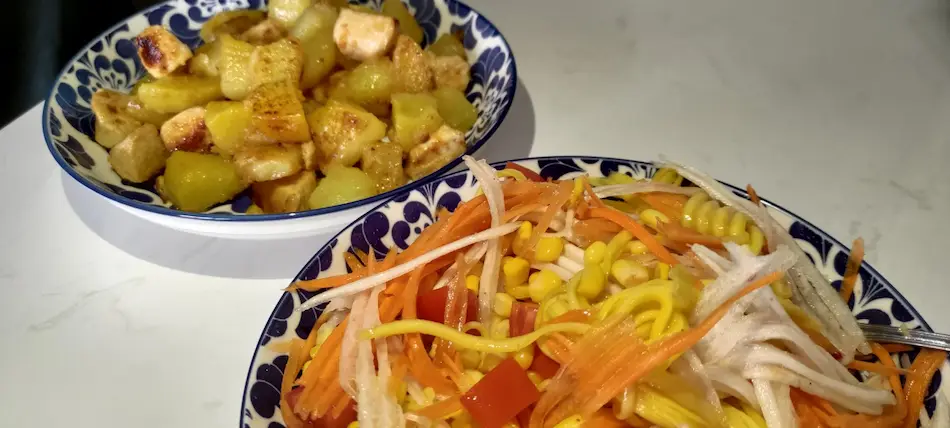
Although I like to cook, I never spend more than 30 minutes on my OMAD meal prep. Potatoes are easy to cook, which is important when I’m short on time.
Porridge
I often choose porridge for my OMAD carbs, but only for my wokrout days. (That’s when I treat myself.)
Here’s photo of my main meal made with porridge, pork loin, and tomatoes.
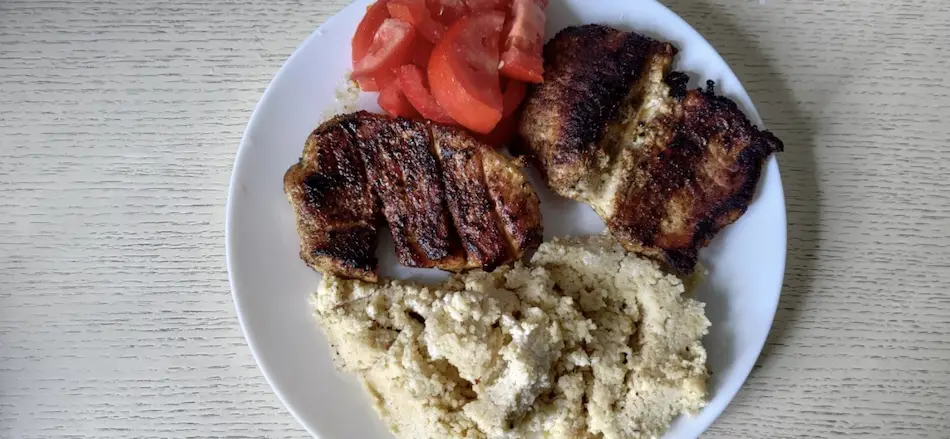
I also like to mix porridge with something sweet as my post-wokrout meal.
It’s usually chocolate chips, dried fruits, frozen fruits, and nuts. It’s easy to make and it keeps me satisfied, without being overly full.
Pasta
We absolutely love pasta in our house. We have it at least 2-3 times a week. Whether it’s spaghetti, tagliatelle, or any other variety, it’s very easy to cook, and it goes well with almost anything.
Try to cook pasta to an al dente texture, not until it’s soft. Apart from the great taste, al dente has been shown to have a lower glycemic index.
Beans
I love beans! They’re so versatile and there are so many different types to choose from.
My favorite beans are lentils and chickpeas, but I also love black beans, kidney beans, and pinto beans.
Althoug I don’t like to cook them as it takes a lot of time.
Here’s the photo of my favorite lentil soup that I like (Yes, the restaurant that we go serves a complimentary shot of vodka!)
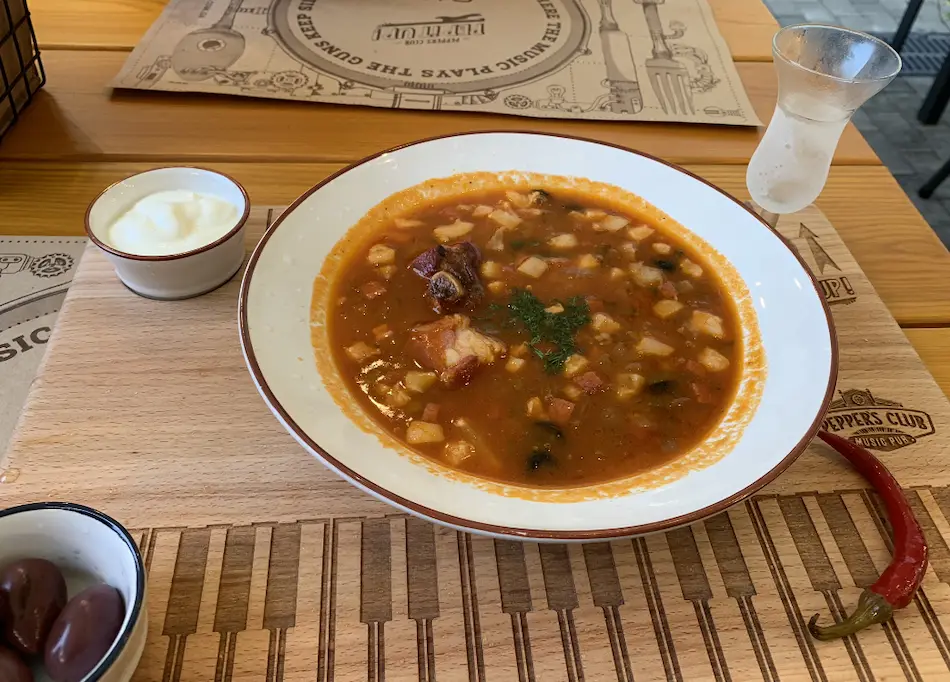
If you don’t take any supplements on OMAD, adding beans is a great way to get your daily dose of fiber, iron, and magnesium. Give them a try and you won’t be disappointed!
Quinoa
Quinoa is rich in minerals and vitamins, making it a very nutritious food. Although quinoa is not my staple food on OMAD, I try to use it as a substitute for rice or pasta.
Additionally, I choose quinoa becasue it’s a great source of protein, making it an ideal food for vegetarians and vegans.
What type of carbs I avoid on OMAD?
- Sugar-sweetened beverages
- White bread
- Pastries
I try to stay away from any refined carbs on OMAD (white flour products, sugar, etc.) becasue they offer little nutritional value.
Here’s photo of fruit smoothie and ice black coffee. The smoothie (obviously) tastes good, but it has a lot of sugar.

I notice a big difference in my energy if I eat (or drink) a lot of sugar. They usually leave me feeling hungry, unsatisfied, and tired.
In contrast, the aforementioned complex carbs provide lasting energy and have essential nutrients like fiber and vitamins.
Choose complex rather than refined carbs to keep your body feeling energetic and healthy.
Should I try doing OMAD without carbs?
I tried to do OMAD without carbs and it didn’t end up well. I felt like I needed to adhere to more rules.
And, when I fall off the wagon, I started to feel guilty, crushed and went down the rabbit hole of more guilt and more shame.
It wasn’t for me.
I find it more sustainable to do OMAD with, rather than without carbs. And, one of the reasons why people NOT losing weight on OMAD is that they get overwhelmed, tired, and eventually quit.
My thoughts on eating carbs on OMAD
Carbohydrates are an important part of a balanced diet, but not all carbs are created equal.
OMAD in itself is not a picnic, so there is no need to deprive yourself of eating what you love.
If you want to start OMAD without eating any carbs, I recommend you try and see how is that gonna work for you for a week or two. Then, make an informed decision about whether or not this is the right move.
Doing the OMAD diet? Share your experience with me below (I answer all the questions)
